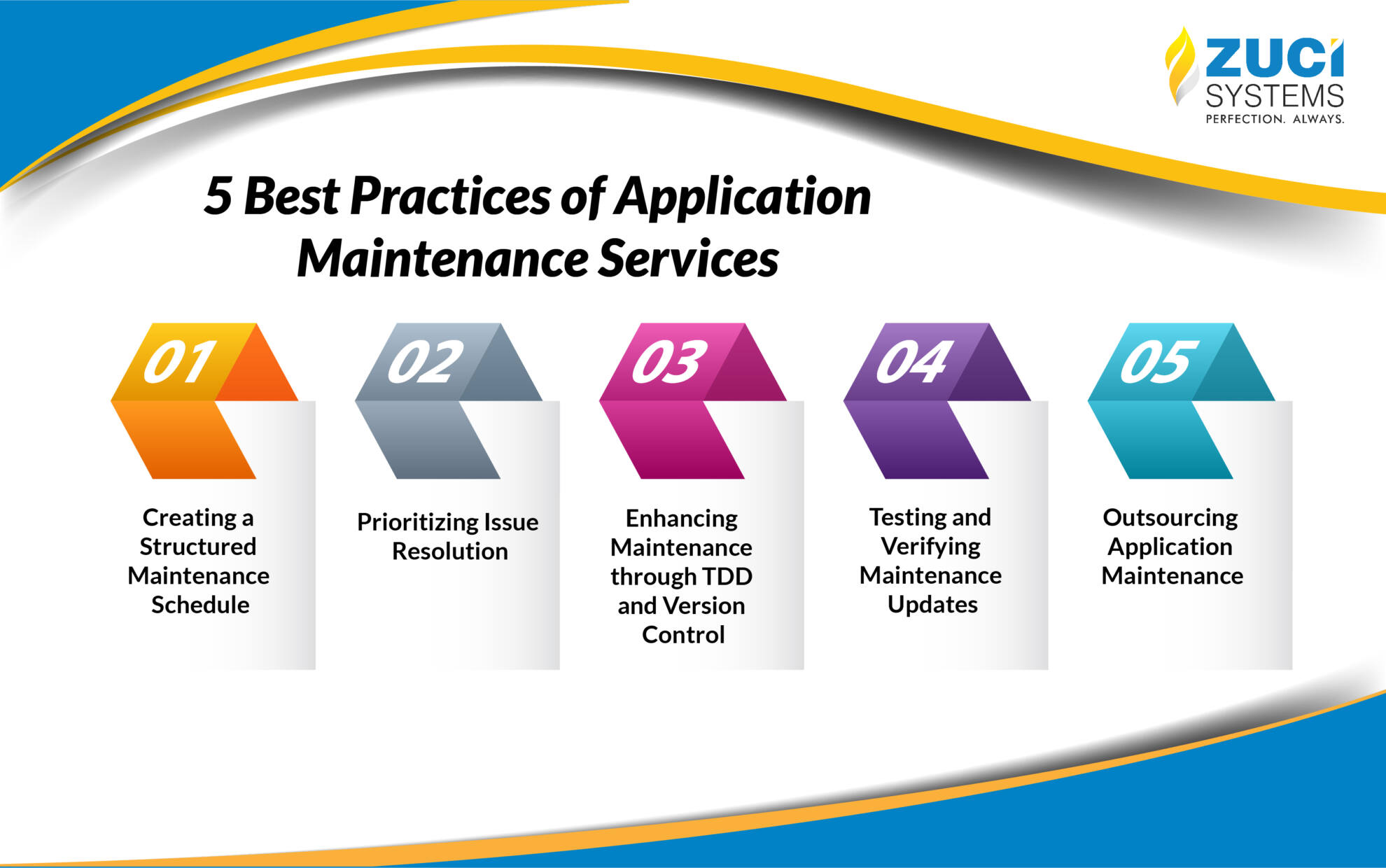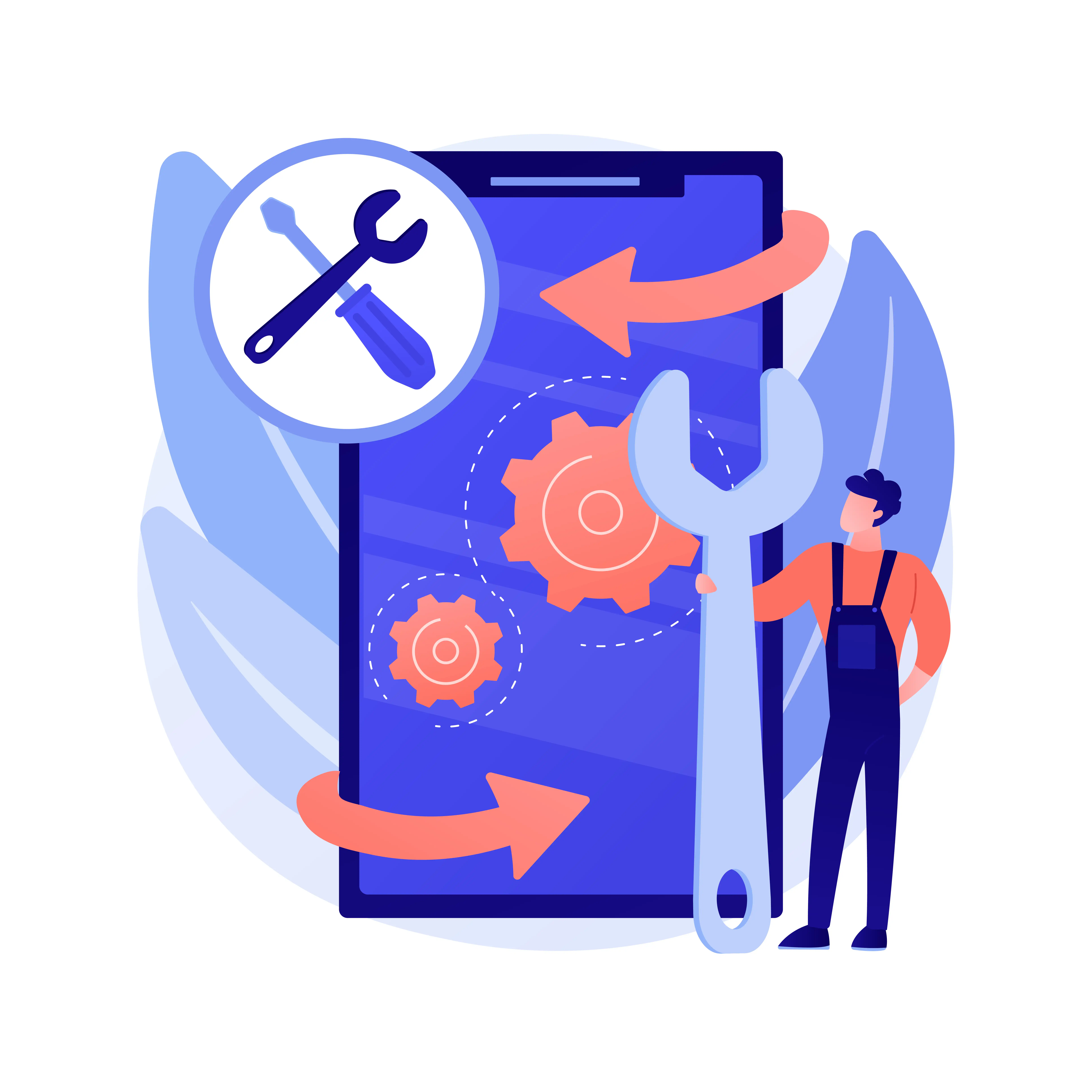5 Best Practices of Application Maintenance Services
Kavya Ravichandran is a skilled content writer with a flair for crafting narratives that educate and engage. Driven by a love for words and an innate curiosity, she explores various topics in the digital space, focusing on application development and modernization, UI/UX design, and emerging technologies like DevOps, AI, and more. She is adept at tailoring her narratives to suit different audiences and platforms, ensuring her work is both relevant and insightful.
How do apps withstand the test of time, retaining their efficiency and relevance in an era where technological advancements occur almost daily? The answer isn’t merely in their creation but rather in the meticulous process of application maintenance.
Application maintenance services are essential throughout a software application’s lifecycle. They begin by addressing initial glitches and bugs post-deployment, ensuring a seamless user experience through regular updates. Security remains a top priority, with continuous patches to counter evolving cybersecurity threats. Compatibility issues with new platforms are resolved, maintaining functional versatility. Scalability demands meticulous performance optimization, while data management, regulatory adherence, and user input necessitate ongoing maintenance. The pursuit of a bug-free experience is relentless. In summary, application maintenance services are crucial at every stage, ensuring reliability, performance, and alignment with changing demands. They constitute the backbone of sustained software longevity, user confidence, and operational excellence in an ever-evolving technological landscape.
Let’s drop some eye-opening stats into the mix:
- 68%: The number of users who would uninstall an app if they encounter two or more bugs. That’s how crucial a glitch-free experience is.
- 80%: The astonishing portion of an app’s total cost that occurs after its initial development and launch. Yes, post-launch maintenance is a substantial investment.
- Only 16%: The fraction of users who would give an app a second chance after a negative first experience. Talk about a one-shot opportunity.
Given these numbers, it becomes evident just how high the stakes are in app maintenance. Bugs and initial impressions can truly make or break an app’s success.
Learn more about application maintenance services, their types, and the benefits they offer in this blog: Why Your Business Should Adopt Application Maintenance Services
Now, let’s dive into the best practices for effective application maintenance services.
A Guide to Best Application Maintenance Practices

1. Creating a Structured Maintenance Schedule
Creating and adhering to a structured maintenance schedule is fundamental in application management. This approach ensures a well-balanced maintenance process that minimizes user disruption while optimizing operational efficiency. By planning maintenance in advance, transparently communicating it to users, segmenting maintenance windows based on factors like time zones, and distinguishing between production and testing environments, organizations can effectively manage the delicate balance between enhancing user experience and maintaining a stable application environment. Regularly tracking the impact of maintenance and making adjustments as needed further demonstrate a commitment to seamless operations. This helps safeguard against unexpected disruptions, reinforces user satisfaction, and promotes a more controlled and systematic approach to application maintenance.
Consider this scenario: Managing a thriving e-commerce platform with global users.
Response: To address this, a well-structured maintenance schedule is implemented, meticulously planning updates and fixes. Timing maintenance during off-peak periods across time zones minimizes disruptions to user activity. Users are proactively informed through in-app messages and emails. Production and testing areas are distinct, ensuring stable performance. Regular impact assessment and adjustment optimize results, leading to fewer disruptions and heightened user satisfaction.
2. Prioritizing Issue Resolution
One fundamental principle revolves around promptly addressing issues. Upon receiving a maintenance notification, the primary step involves evaluating a list of identified issues for resolution. This encompasses concerns reported by users, as well as those impacting user experience and regular operations. The essence lies in prioritizing these issues – a strategy that aids in determining urgency and pinpointing when necessary patches should be applied. The user’s perspective plays a pivotal role, propelling the maintenance team to pose essential questions regarding the issue’s significance and the potential consequences of delay. In cases where numerous issues require attention, the key lies in addressing user-related concerns first, subsequently charting the order of resolution for others.
Consider this scenario: Following an update, users can’t access their account balance due to a bug.
Response: Swift action is taken as this issue affects user experience and daily operations. By promptly addressing it, the team shows a user-centric approach, ensuring satisfaction and trust in the app’s reliability.
3. Enhancing Maintenance through TDD and Version Control
To optimize application maintenance, it’s crucial to adopt a Test-Driven Development (TDD) approach, which involves writing tests before coding to ensure functionality, ease updates, enhance documentation, validate changes continuously, and reduce technical debt. Additionally, using Source Control and Version Management tools is essential. These tools maintain a code history, enable collaboration among developers, provide rollback and recovery options, support organized development through branching and merging, and help enforce security and compliance standards. These practices collectively streamline maintenance efforts, ensuring code quality, effective collaboration, and robust code management.
Consider this scenario: A software company manages a high-traffic e-commerce platform.
Response: To maintain reliability and meet customer demands, they adopt Test-Driven Development (TDD), writing tests before coding to ensure smooth updates and quick issue resolution. They also use Source Control and Version Management tools, allowing collaborative development, rapid rollbacks, and compliance enforcement. These practices streamline maintenance, ensuring code quality and responsive management of a critical e-commerce site.
4. Testing and Verifying Maintenance Updates
Testing maintenance updates is crucial to enhance application reliability and performance. After completing the maintenance phase, testing within a non-production replica environment is recommended. This involves a control test to establish a baseline, applying a single update, and re-running tests to confirm expected changes and identify undesired alterations. These tests should occur in a non-production maintenance window, allowing for precise tracking of update application time and ensuring the application remains reliable and user-friendly. Validation in the production environment mirrors the non-production tests, promoting consistency and reducing discrepancies. Overall, this approach ensures that desired outcomes are achieved, enhancing the maintenance process’s reliability and predictability.
Consider this scenario: Users report occasional image loading glitches in their feeds.
Response: To address this, a maintenance update is planned. Testing is crucial before applying it. This involves checking the platform’s behavior without the update and then testing it with the update applied. The goal is twofold: to confirm issue resolution and prevent new problems. Tests are timed for accuracy. Thorough testing maintains platform reliability, ensuring users benefit from a seamless experience and averting unexpected disruptions. This highlights the critical role of testing in upholding application functionality and user satisfaction.
You Might Also Be Interested In:
Performance Testing: Optimize your system for a crash-proof performance
5. Outsourcing Application Maintenance
Outsourcing application maintenance emerges as a best practice rooted in the need for specialized expertise. It’s recognized that maintaining an application for optimal efficiency, peak performance, and adherence to best practices requires a dedicated team of skilled specialists. The decision to outsource not only simplifies the complexities associated with maintenance but also ensures consistent and timely updates. Leveraging the experience, workflows, and technologies of an outsourcing partner, comprehensive maintenance updates span across the entirety of your technology stack. This strategic collaboration grants a competitive edge and frees resources to concentrate on core business priorities, enhancing overall productivity and efficiency.
Consider this scenario: A software development company with a popular project management app outsources maintenance.
Response: By partnering with experts to ensure regular updates, minimize disruptions, and enhance user satisfaction, the company’s internal team can concentrate on core functionalities, thus amplifying the app’s overall value and competitiveness.
Final Thoughts:
In conclusion, following these best practices can make a significant difference in your application’s maintenance. Prioritize issue resolution, test updates carefully, consider outsourcing when needed, stick to schedules, and support your users consistently. Maintenance success relies on careful planning, a user-focused approach, and proactive actions.
At Zuci Systems, we understand the significance of these best practices, and we’re here to assist you in implementing them effectively. Our team of experts is dedicated to supporting your application maintenance journey, ensuring your digital assets remain reliable and future-ready. With the right practices and the right partner, your application can thrive and stand the test of time. To explore our services and discover how we can help you navigate the dynamic landscape of application maintenance.
FAQs:
1. How do you prioritize maintenance tasks and allocate resources efficiently?
Prioritizing maintenance tasks involves considering factors like business impact, severity of issues, user feedback, compliance requirements, and strategic goals. Resource allocation depends on task priorities, team expertise, workload balancing, and the use of automation tools.
2. How do you ensure smooth transition and knowledge transfer during handover of maintenance responsibilities?
Smooth transition and knowledge transfer during handover involve documenting system architecture, configurations, processes, and known issues. Conducting training sessions, creating runbooks, establishing communication channels, and shadowing sessions can facilitate a seamless transfer of responsibilities between teams.
3. How should regression testing be incorporated into application maintenance practices?
Regression testing should be conducted after every change or update to ensure that new code does not adversely affect existing functionality. Automated testing tools can help streamline this process and ensure comprehensive test coverage.
4. What measures can be taken to manage technical debt during application maintenance?
Regular code refactoring, addressing code smells, and prioritizing technical debt reduction tasks alongside feature development can help manage technical debt. Establishing code review practices and utilizing static code analysis tools can assist in identifying areas of improvement.
5. How should version control and release management be handled in application maintenance?
Implementing version control systems like Git and following branching strategies such as GitFlow or feature branching ensures organized and controlled code changes. Release management practices, including release notes, version tagging, and rollback procedures, help maintain transparency and reliability during deployments.
Other Reads:
The Importance of Regular Application Maintenance for your Product
Related Posts
























